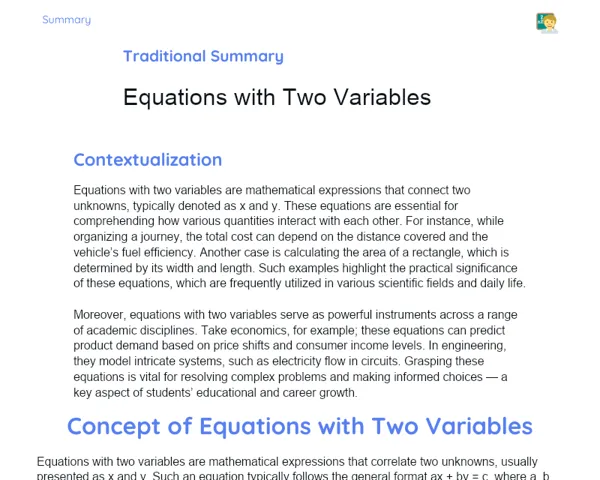Goals
1. Grasp the concept of the cofactors matrix.
2. Compute the cofactors matrix from a given matrix.
3. Utilize the cofactors matrix to determine the inverse matrix.
Contextualization
Matrices are essential mathematical tools that we encounter in many real-world applications. Whether it's in digital image processing or modeling intricate economic systems, a solid grasp of matrix operations is crucial. Specifically, the inverse matrix is vital for solving linear systems and reversing linear transformations. For instance, in engineering, the inverse matrix is employed to resolve equations that model structural and electrical challenges. Similarly, in data science, it plays a key role in managing extensive datasets and executing regression analyses.
Subject Relevance
To Remember!
Cofactor Matrix
The cofactors matrix comprises the cofactors corresponding to each element of the original matrix. Each cofactor is derived by omitting the respective row and column of the element in focus and computing the determinant of the smaller resulting matrix, keeping in mind an alternating sign based on the position of the element.
-
Calculating the cofactors matrix is essential for finding the inverse matrix.
-
Each entry in the cofactors matrix is the determinant of a smaller submatrix, multiplied by an alternating sign.
-
The cofactors matrix finds applications in numerous linear transformations and complex calculations across various fields.
Inverse Matrix
The inverse matrix of a square matrix is another matrix that, when multiplied by the original, yields the identity matrix. Matrix inversion is a crucial step in various mathematical processes and practical applications, like solving systems of linear equations.
-
Finding the inverse matrix is fundamental in resolving systems of linear equations.
-
Not every matrix can be inverted; only square matrices with a non-zero determinant are eligible.
-
Inverse matrices are extensively utilized in computer graphics and numerical computations.
Determinant
The determinant is a scalar value derived from a square matrix. It provides essential insights about the matrix, such as whether it is invertible and the volume of the linear transformation represented by the matrix.
-
The determinant helps ascertain the invertibility of a matrix.
-
A zero determinant indicates that the matrix lacks an inverse.
-
Calculating these determinants is a vital step in deriving the inverse matrix.
Practical Applications
-
In engineering, the inverse matrix is applied to solve equations that model structural issues and electrical systems.
-
In data science, the inverse matrix is crucial for managing large datasets and executing regression analysis.
-
In computer graphics, inverse matrices are used for performing image transformations and effects, such as rotation and scaling.
Key Terms
-
Cofactor Matrix: A matrix composed of the cofactors of a given matrix, used for calculating the inverse matrix.
-
Inverse Matrix: A matrix that results in the identity matrix upon multiplication by the original matrix.
-
Determinant: A scalar that signifies whether a matrix is invertible and gives insights about the associated linear transformation.
Questions for Reflections
-
How can mastering the inverse matrix aid you in solving complex challenges in your prospective career?
-
In what ways is matrix manipulation utilized in different sectors of the job market?
-
Why is it critical to master techniques for calculating the cofactors matrix and the inverse matrix for your academic and career development?
Hands-On Challenge: Calculating the Inverse of a Matrix
In this mini-challenge, you will put into practice what you've learned about the cofactors matrix and the inverse matrix to tackle a real-world problem.
Instructions
-
Team up with 3 to 4 classmates.
-
Obtain the 3x3 matrix shared by the instructor.
-
Compute the cofactors matrix from the provided matrix.
-
Determine the transpose of the cofactors matrix.
-
Calculate the determinant of the original matrix.
-
Multiply the transpose of the cofactors matrix by the reciprocal of the determinant of the original matrix to derive the inverse matrix.
-
Prepare a concise 5-minute presentation detailing the process and findings.



